Zabeel Palace: Exploring Its Historic and Cultural Impact
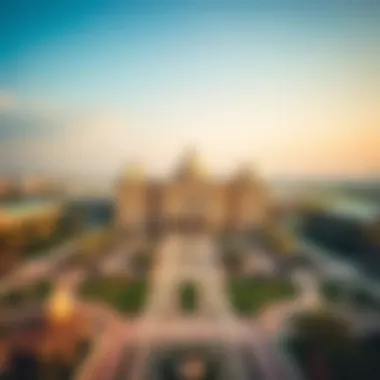
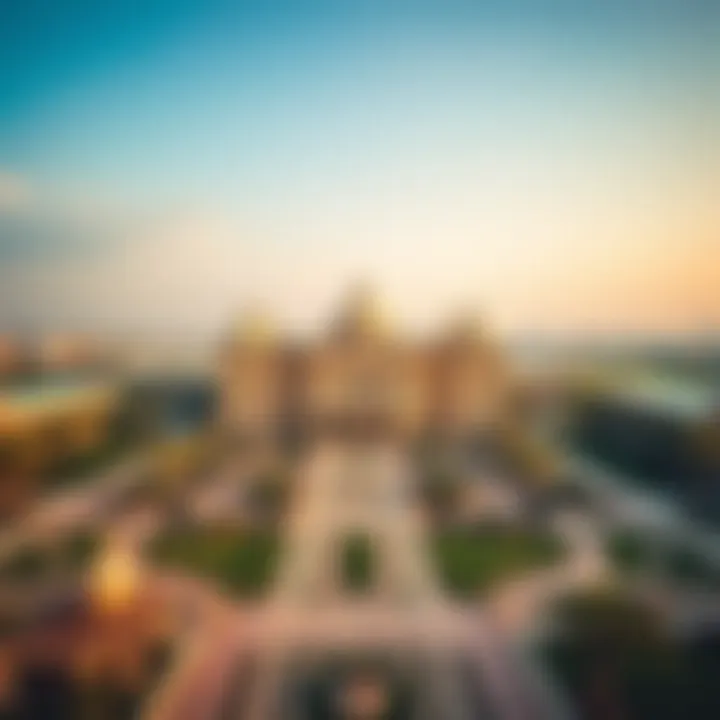
Intro
Nestled within the expanding horizon of Dubai, Zabeel Palace serves as a magnificent bastion of history and culture. While it boasts stunning architecture and lush gardens, its significance extends far beyond mere aesthetics. This palace, the residence of Dubai's ruling family, encapsulates a rich tapestry of the emirate's past, its present, and the dynamic lifestyle that defines its future.
Zabeel Palace's contributions are manifold—it interweaves the traditional and the contemporary, symbolizing the rapid development Dubai has undergone in the last few decades. For investors, homebuyers, and expatriates, understanding this palace’s role offers insights not only into the heritage of Dubai but also into its real estate market dynamics. As we embark on an exploration of Zabeel Palace, we’ll uncover its historical journey, architectural splendor, and the cultural narratives that shape the community around it.
Prelims to Zabeel Palace
Zabeel Palace stands as a significant landmark, intertwining history, culture, and architecture in the vibrant tapestry of Dubai. It is not just the residence of the ruling family; it serves as a symbol of the emirate's development and global standing. As one delves into the layers of this majestic palace, one finds a reflection of the region's evolution, from a modest trading post to a flourishing metropolis. The palace itself, encompassing an array of intricate designs and features, tells a story that resonates with both tradition and modernity.
Understanding Zabeel Palace can offer valuable insights to various stakeholders. Investors and homebuyers may look at its surrounding area, assessing how its royal proximity impacts real estate values. Developers could gain a sense of how the palace influences architectural trends in Dubai. Meanwhile, expatriates find that the palace represents stability and prosperity within the city’s dynamic landscape.
In exploring the fundamental aspects of Zabeel Palace, we will cover:
- Its historical roots and milestones that shaped its current structure.
- The cultural and social significance it holds in Dubai's growing identity.
- Insights into how Zabeel Palace not only reflects history but also symbolizes aspirations of the people living in and around Dubai.
Through this exploration, readers can appreciate not just the grandeur of Zabeel Palace but also its role in fostering community ties in this ever-evolving urban environment.
Historical Background
Constructed in the late twentieth century, Zabeel Palace has a historical narrative closely tied to the Al Maktoum family, which governed Dubai ever since the early 19th century. Originally built as a residence, the palace has grown to become a haven for ceremonial events and governmental functions. Its foundation laid the groundwork for supreme leadership in the region.
Back then, the Dubai we know today was just beginning to form. The palace's establishment reflects the aspirations of Sheikh Rashid bin Saeed Al Maktoum, who envisioned Dubai as a global trade and transit hub. The architectural layout of the palace, complemented by its expansive gardens, symbolizes a blend of traditional Arab design and modern functionality.
Particularly interesting is how the palace has adapted over the years, not only serving as a royal residence but also hosting key political dialogues and cultural events. Through this lens, Zabeel Palace encapsulates the transition of Dubai from a lesser-known entity to a world-renowned metropolis.
Significance in Dubai's Landscape
Zabeel Palace is more than just a regal residence; it is a cornerstone in the landscape of Dubai. The structure dominates the skyline in its area, becoming a point of unfamiliar familiarity for locals and tourists. Its extensive grounds and distinctive architecture serve as a reminder of the city's unique cultural heritage.
In today's fast-paced environment, Zabeel Palace symbolizes stability amidst rapid urban development. It reminds residents of their rich traditions, while at the same time it stands as a beacon for progress. The surrounding neighborhoods benefit directly from its prestigious location, making properties nearby highly sought after.
Moreover, the palace plays an essential role in public life. It influences city planning and has involved many major developments in its vicinity, from luxurious residential spaces to green parks designed for public enjoyment.
Through its historical and ongoing relationship with the city, Zabeel Palace provides a valuable lens for understanding not just the past of Dubai, but its aspirations for the future.
Architectural Features of Zabeel Palace
When considering the significance of Zabeel Palace in the context of Dubai, its architectural features play a pivotal role. The palace is not merely a residence; it's a symbol of the emirate's ambition and cultural heritage. The elements integrated into its design and structure reflect both historical reverence and modern aspirations. Understanding these features provides valuable insight into not just the palace itself but also the broader landscape of luxury living in Dubai.
Design Elements
The design of Zabeel Palace is a meticulous blend of intricate Islamic architectural traditions and contemporary flair. At a glance, one might notice the grand arches and domes, each serving a distinct aesthetic purpose while paying homage to Middle Eastern architectural norms. These elements create a sense of harmony and elegance, essential for a residence of such standing.
In addition to visual grandeur, the layout of the palace is purposefully crafted. The spacious courtyards invite natural light and facilitate airflow, which was a key consideration in desert architecture. The use of water features, like fountains, further enhances the ambiance, contributing to a serene environment. The landscaping surrounding the palace complements the structure, with lush gardens that contrast with the urban backdrop of Dubai.
A notable aspect is the balance in design that merges functionality with opulence. The high ceilings and large windows boast both aesthetic beauty and practical benefits, ensuring the interior remains cool even in scorching heat. This intelligent design structure reflects the palace's dual role as both a home and a ceremonial venue, accommodating gatherings that range from intimate family celebrations to grand state functions.
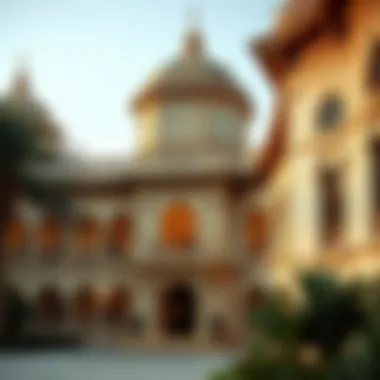
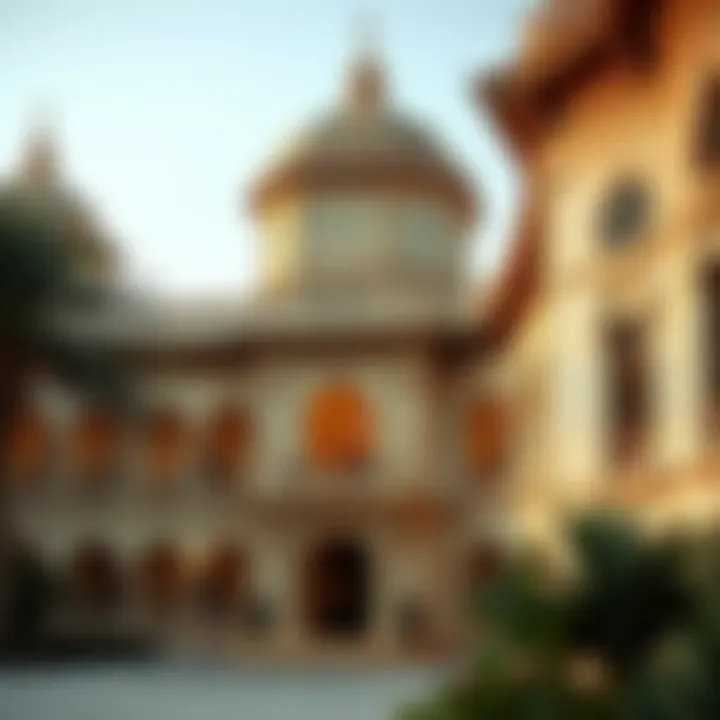
Material Usage
The choice of materials utilized in Zabeel Palace's construction is equally noteworthy. Predominantly, local materials were employed, showcasing the region's resources and craftsmanship. For instance, the use of limestone not only offers durability but also resonates with the traditional building practices of the UAE. This choice fosters a connection to local culture that is essential in a place like Dubai, where heritage often meets modernity.
In addition to limestone, gold leaf and intricate mosaics adorn many of the palace interiors, symbolizing wealth and artistry. The detailed craftsmanship seen in these materials elevates the palace from mere structure to a work of art. This meticulous attention to detail speaks volumes about the values upheld within the palace and reflects the commitment to maintaining a rich cultural narrative amidst rapid development.
The architectural choices express a narrative, showcasing the emirate's identity as it evolves while remaining rooted in its history.
Ultimately, when one steps back to examine the architectural features of Zabeel Palace, it’s clear that the design and material considerations are not just for show. They serve to enrich the social fabric of Dubai, enriching life for residents and visitors alike while embodying the luxury lifestyle that has come to define this vibrant city.
The Ruling Family and Zabeel Palace
The Zabeel Palace is more than just an impressive piece of architecture; it serves as a cornerstone of Dubai's social and political landscape due to its deep-rooted connections with the ruling family. The significance of the palace extends beyond mere aesthetics, reflecting the royal family’s authority and cultural heritage in the emirate. Understanding the ties of the palace to the ruling family is essential for grasping its importance within Dubai’s historical and contemporary context.
Historical Ties to the Royal Family
Zabeel Palace has a historical essence intertwined with the Al Maktoum family, whose leadership has been pivotal in shaping Dubai from a small fishing village into a thriving metropolis. The palace was constructd in the late 20th century and has since served as the home of several Sheikh's. It symbolizes the transition of leadership and the family’s commitment to their people.
During the reign of Sheikh Rashid bin Saeed Al Maktoum, the palace marked a period of rapid development. Sheikh Rashid's vision to transform Dubai's economy led to unparalleled growth in infrastructure and public services, directly affecting the everyday lives of residents. Visitors often remark how the palace stands as a monument to the past, reminding the citizens of the foundation upon which Dubai’s success is built. In this sense, Zabeel Palace is not merely a residence; it embodies the rich history of governance, tradition, and a harmonious bond between the ruling family and the people.
Ceremonial Functions and Traditions
Beyond its historical significance, Zabeel Palace hosts many ceremonial functions that underscore its cultural relevance in Dubai. Events ranging from national celebrations to royal weddings occur on its grounds, making it a hub for traditions that define Emirati identity. During important religious observances such as Eid, the palace opens its doors for public gatherings, a gesture that reinforces the family’s relationship with its citizens.
Furthermore, the palace is pivotal to state affairs and international relations, often serving as the venue for official meetings and state visits. High-profile dignitaries and foreign leaders are often received here, fostering diplomacy and dialogue vital to the UAE's geopolitical standing.
"Zabeel Palace stands as a living testament to the lineage and legacy of the Al Maktoum family, weaving together the past and present with a vision for the future."
In addition to those events, the palace is steeped in traditions passed down through generations, reinforcing values of generosity and hospitality that are integral to Emirati culture. The sight of decorated halls during festivities leaves a lasting impression, emphasizing how these ceremonies are not just events; they are a tapestry of history and identity, rich with the very essence of what it means to be part of Dubai’s community.
Understanding the significance of Zabeel Palace from this perspective is crucial for any investor or expatriate looking to engage with the Dubai real estate market. The palace is not just a backdrop; it symbolizes stability, heritage, and a forward-thinking vision that influences the entire emirate.
Cultural Impact of Zabeel Palace
Zabeel Palace holds a profound place in Dubai, representing more than just architectural splendor. Its cultural impact extends into various facets of life, providing a unique insight into the heritage and the aspirations of the emirate. The palace does not merely stand as a relic of the past; it's a dynamic symbol that influences the community, nourishes traditions, and resonates with Dubai's evolving identity.
Symbol of Heritage
Zabeel Palace is often heralded as a beacon of Dubai’s rich heritage, encapsulating the essence of Emirati culture. The palace embodies the historical narrative of the ruling family and the nation’s commitment to preserving its traditions. The architectural style, heavily inspired by classic Islamic motifs, serves as a reminder of the region's roots while simultaneously embracing modernity.
The surrounding gardens and landscape design are no less significant. Visitors often remark on how these elements reflect an age-old connection to nature and hospitality, integral to Emirati values. Each element of the palace tells a story—one that celebrates past triumphs and acknowledges ongoing dialogues between the old and the new.
"Zabeel Palace is more than just a building; it's a living museum that narrates the story of a nation’s journey from tradition to modernity."
In events of national importance or state visits, the palace becomes a focal point. Ceremonies held within its walls are steeped in cultural practice, showcasing heritage through music, art, and ceremonial dress. For locals, these occasions are not just mere gatherings; they solidify the communal identity and foster a sense of belonging that transcends individual experiences.
Community Engagement
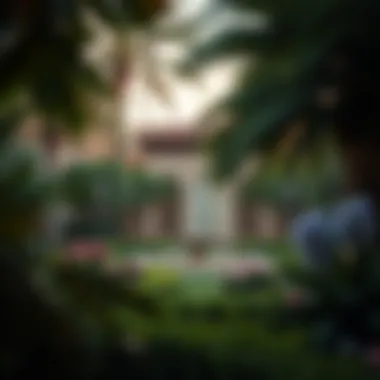
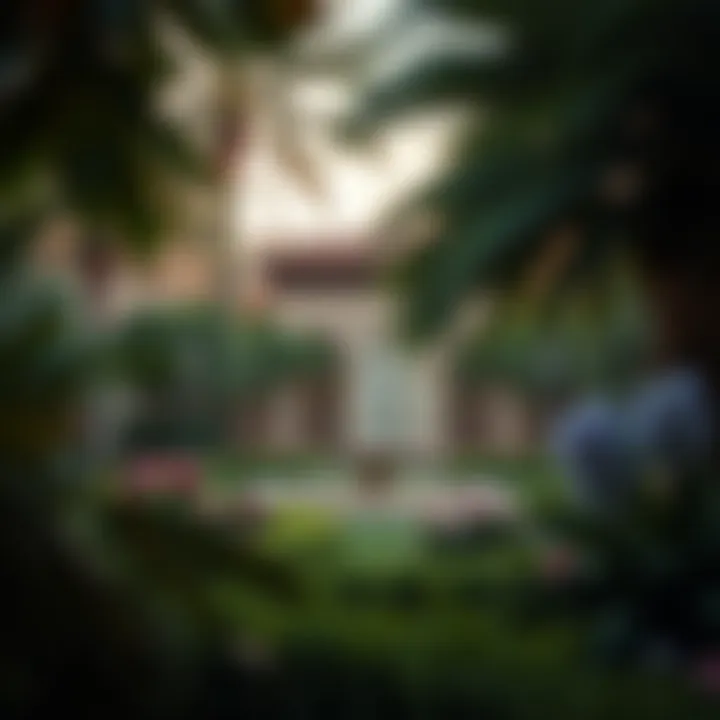
The role of Zabeel Palace extends into vibrant community engagement as well. While the palace itself is not typically open to the public, its influence permeates through various outreach initiatives. For instance, during national celebrations or public festivals, the palace often serves as a backdrop for grand displays of traditional Emirati culture. This provides an avenue for locals and expatriates alike to engage with the customs and practices that define this unique region.
Moreover, local art exhibitions and cultural forums have been known to congregate around the vicinity of the palace. Such events encourage artistic expression and foster dialogue among community members, allowing for the exchange of ideas between artists and audiences. This engagement cultivates a rich mosaic of cultural dynamics that underpins Dubai’s social fabric.
These initiatives often inspire economic benefits too—small businesses capitalize on increased foot traffic during events, and cultural tourism flourishes as visitors seek authentic experiences tied to the very core of Emirati identity.
As a hinge between the past and the future, Zabeel Palace nurtures an environment where culture and community thrive. It is an emblem of both pride and progression, propelling the emirate toward a future that honors its ancestral legacy while welcoming modern influences.
In essence, the cultural impact of Zabeel Palace on Dubai is significant. It stands not only as a royal residence but as a catalyst for heritage preservation and community engagement, enriching the lives of both locals and newcomers.
Zabeel Palace and Real Estate Dynamics
Zabeel Palace stands as not just a prominent landmark in Dubai but also as a pivotal influencer in the real estate market of the emirate. Located strategically in an area that is rich in cultural significance and luxury, it has a substantial impact on property values and investment trends. The palace embodies a blend of history and modernity, serving as a touchstone for developers and investors looking to understand the market dynamics surrounding one of the most notable areas in Dubai.
Surrounding Development
The surroundings of Zabeel Palace have evolved significantly over the years. Once dominated by open spaces and smaller structures, the area has experienced rapid development. High-end residential complexes, luxury villas, and commercial hubs surround the palace, each contributing to the upscale reputation of the region. The Zabeel neighborhood has become a coveted address, attracting affluent individuals and families who appreciate not only the regal ambiance but also the modern conveniences that the area offers.
Several notable projects, such as the Dubai Frame and the expansive parks that have sprouted around, highlight the dedication of Dubai into crafting a dynamic and attractive urban environment. This has naturally affected the local real estate market. Investors are keenly watching the rising property values in response to such developments. Property prices in the vicinity have seen an uptick, which speaks volumes of the palace's influence as a cultural and historical touchstone that enhances the area’s desirability.
Market Trends Influenced by the Palace
The presence of Zabeel Palace is pivotal in shaping market trends in Dubai's real estate landscape. The royal heritage associated with the palace adds gravitas to property listings nearby. Homebuyers and investors are drawn to areas that signal prestige and exclusivity. As such, proximity to Zabeel Palace often results in higher demand for real estate, leading to increased prices.
Currently, some trends worth noting include:
- The surge in demand for luxury residential properties, particularly from expatriates looking for stable investments.
- A marked interest in commercial real estate, as businesses wish to position themselves within a prestigious radius of the palace.
- Growing trends towards sustainability in new developments, which aligns with the palace’s commitment to preserving the environment and cultural heritage.
The palace’s ongoing renovations further attract attention, keeping the vicinity vibrant and desirable. Investors often use the ongoing status of the palace as a litmus test for property values, making calculated decisions based on its continued relevance in Dubai’s evolving landscape.
"Zabeel Palace is more than just a royal residence; it is a cornerstone of the real estate narrative in Dubai, guiding investment choices and market demands effectively."
In summary, Zabeel Palace anchors the real estate dynamics in its neighborhood. It not only preserves the cultural and historical essence of Dubai but also promotes an ever-evolving real estate market driven by luxury, prestige, and modern living.
Lifestyle Aspects Associated with Zabeel Palace
Zabeel Palace is more than just a stunning architectural marvel; it's a centerpiece of a vibrant lifestyle in Dubai. This luxurious landmark invites examination of how it influences community living, enhances quality of life, and affects local market dynamics. Understanding these lifestyle aspects sheds light on the cultural fabric of the surrounding area, and what it offers to residents and visitors alike.
Luxury Amenities
The vicinity surrounding Zabeel Palace boasts a wealth of luxury amenities that reflect the opulence associated with the palace itself. High-end hotels, gourmet restaurants, and upscale shopping centers are all within arm's reach. For instance, you’ll find the Jumeirah Emirates Towers nearby, offering exquisite dining with a view of the palace. These establishments are more than just businesses; they create an atmosphere of sophistication and elegance.
Moreover, community parks such as Zabeel Park provide an oasis of greenery in the bustling city. Residents enjoy jogging trails, children’s playgrounds, and picnic areas, promoting a healthy and vibrant lifestyle. It's where families gather, unwinding in the shadow of nearby skyscrapers. As a bonus, the proximity to cultural institutions like the Dubai World Trade Centre adds to the richness of life in the area.
Key amenities in the vicinity include:
- Luxury hotels such as the Ritz-Carlton and the Address Downtown
- Private schools with excellent academic reputations
- Fitness centers that cater to diverse wellness needs
- Exclusive skating rinks and golf clubs that attract sports enthusiasts
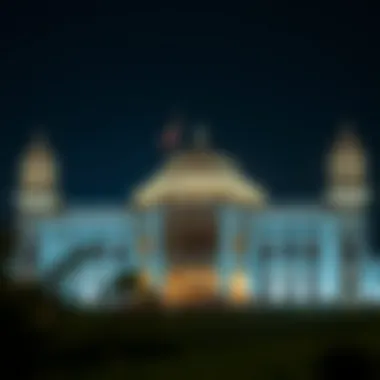
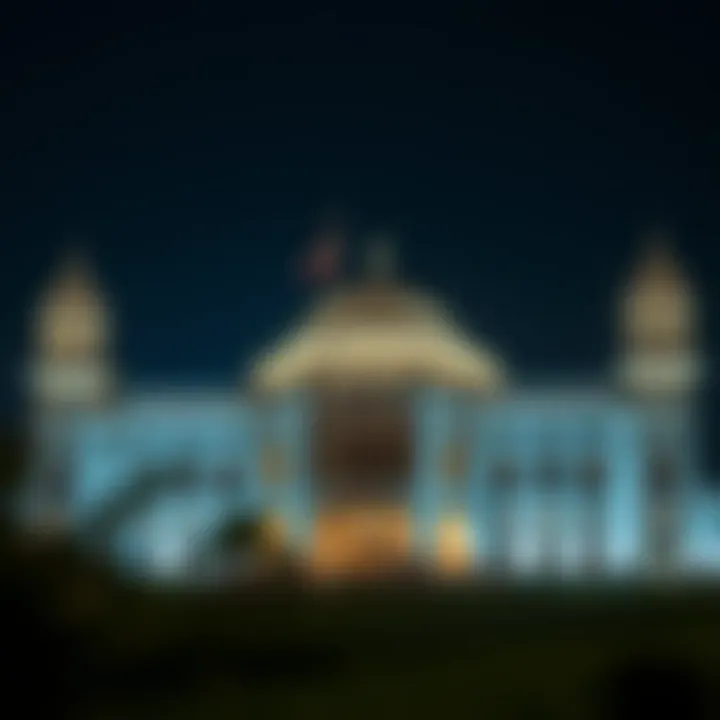
Together, these amenities enhance the lifestyle experience people enjoy while living near Zabeel Palace, ensuring convenience is always just a step away.
Community Life in the Vicinity
Living near Zabeel Palace offers a unique blend of privacy and togetherness. The neighborhood thrives with both expatriates and locals, fostering a multicultural environment where traditions intermingle. This unique tapestry of cultures brings about a community that celebrates diversity through festivals, art, and food.
Regular events hosted within the palace grounds or in nearby venues further solidify this sense of community. Neighborhood gatherings reflect the spirit of collaboration, where residents come together for seasonal festivals, cultural exhibitions, and food markets. This connectivity among residents helps create a strong social fabric, giving rise to vibrant interactions.
In addition, communal initiatives like local farmer's markets not only promote healthy eating but also allow residents to engage directly with local producers. The engagement fosters relationships and ensures that everyone feels part of the community.
Ultimately, the lifestyle aspects associated with Zabeel Palace extend beyond mere luxury or amenities. They encapsulate a broader ethos of community living that enhances daily life, making it an attractive option for investors, homebuyers, and anyone looking to be part of Dubai's exceptional growth story.
"Lifestyle near Zabeel Palace is not simply about affluence; it's a symbiosis of culture, community, and comfort that captures what living in Dubai is all about."
For more information on Dubai's lifestyle, visit Dubai Tourism and Visit Dubai.
The Future of Zabeel Palace in Dubai
The upcoming narrative surrounding Zabeel Palace is as important as its rich history. As Dubai continues to evolve, the palace stands at the crossroads of tradition and modernism. Its future is not just about preservation; it also encompasses the engagement of the community and integration into the broader identity of Dubai. Understanding this future landscape helps us appreciate how Zabeel Palace remains relevant amid rapid urban growth.
Prospects for Preservation and Promotion
The preservation of Zabeel Palace is essential for maintaining the historical fabric of Dubai, a city that often grapples between its rapid advancements and its heritage. To ensure that this architectural gem remains a focal point in Dubai, several initiatives are currently being discussed. These include:
- Restoration Projects: Investing in restoration efforts is crucial. As the palace requires upkeep, restoration projects will focus on methods that protect the original materials and architectural styles.
- Public Engagement: Increasing public awareness about Zabeel Palace is key. Programs that encourage school tours or community events can foster a greater appreciation for the palace and its significance.
- Cultural Events: Hosting cultural events or exhibitions at the palace can also promote its legacy. This not only attracts tourists but also local residents who wish to connect with their heritage.
By fostering this blend of historical integrity and community involvement, Zabeel Palace can maintain its status as a key landmark.
Integration into Dubai’s Modern Identity
As Dubai races forward into the future, Zabeel Palace serves as a bridge between the ancient and the contemporary. Its integration into Dubai’s modern identity involves:
- Architectural Harmony: Not only does the palace boast traditional craftsmanship, but its position among modern skyscrapers symbolizes the coexistence of various eras of design. This harmony is what makes Dubai immensely appealing to investors and developers.
- Civic Identity: The palace’s role in civic matters reflects its importance. It stands not merely as a royal residence but also as a venue for significant diplomatic and community interaction.
- Commercial Development: Given its prime location, the area surrounding Zabeel Palace is being developed with luxury and commercial properties, enhancing the economic landscape. This careful planning can create a vibrant environment that attracts expatriates and homebuyers.
Overall, Zabeel Palace is not just a relic of the past; it has an active role in shaping Dubai’s future, ensuring that while the world looks ahead, it also acknowledges where it has come from.
The End
The conclusion of this exploration serves as a critical summation, tying together the threads of history, architecture, and culture that make Zabeel Palace a cornerstone of Dubai's identity. In discussing the significance of this landmark, it's crucial to underscore its multifaceted role within the emirate.
Summary of Key Insights
Zabeel Palace stands not merely as a residence but as an emblem of the emirate's heritage and pride. Here are the key insights:
- Historical Ties: The palace's long history with Dubai’s ruling family allows it to embody the evolution of governance and family legacies in the region.
- Architectural Marvel: Its striking design reflects a blend of traditional Arabian motifs with modern architectural innovations, making it a visual masterpiece.
- Cultural Symbol: The palace functions as a venue for major events and ceremonies, reinforcing its status as a cultural centerpiece.
- Economic Impact: The surrounding developments and real estate dynamics influenced by the palace showcase its role in shaping Dubai's economic landscape.
- Future Prospects: Looking ahead, the integration of Zabeel Palace into Dubai’s modern identity signals a commitment to preserving history while promoting development.
These points encapsulate how the palace is not just a physical structure but a narrative of Dubai's journey.
Final Thoughts on Zabeel's Significance
As we look at Zabeel Palace, it’s clear it represents more than ornate architecture or royal legacy; it embodies the spirit of Dubai itself. For investors, homebuyers, and expatriates alike, understanding the significance of Zabeel can inform choices not just related to real estate, but also about culturally rich experiences in Dubai. The palace plays a pivotal role in shaping perceptions about the emirate, balancing tradition with modernity.
By recognizing Zabeel Palace as both a historical fixture and a symbol of ongoing evolution, stakeholders can appreciate the depth of its influence in Dubai’s continuing story. As developments unfold, the palace will likely remain a beacon, guiding the trajectory of the city while remaining grounded in its distinguished past.



